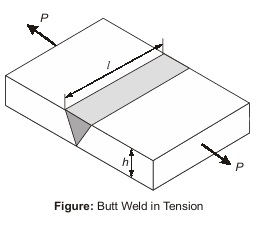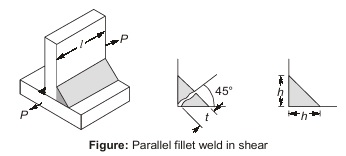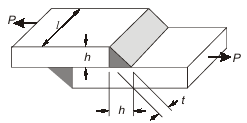Strength of Welded Joints
(i) Strength of Butt Weld
A butt welded joint, subjected to tensile force P, is shown in given figure.
Here,
σt = Tensile stress in weld
P = Tensile force on the plates (N)
h = Throat of Butt weld
t = Thickness of plate
l = Length of weld
σt = P/hl
Because reinforcement is provided to compensate for flaws in the weld, equating throat of the weld ‘h’ to the plate thickness ‘t’.

σt = p/lt
For safety, there must be reduction in strength of a butt welded joint by a factor called “Efficiency of Joint”.
P = η σt t l
η = Efficiency of welded joint
(ii) Strength of Parallel Fillet Joint
A parallel fillet weld subjected to a tensile force P is shown below.

h = Leg of weld (size of weld)
t = Throat (it is the minimum cross-section of weld at 45° to leg)
l = Length of weld
t = h cos (45°)
t = 0.707 h (for right-angle triangle with two equal side)
Generally the leg length ‘h’ is equal to the plate thickness.Because failure of the fillet weld occurs due to shear along the minimum cross-section of the weld.
Permissible shear stress, τmax = P/tl = P/ 0.707hl
If there are two welds of equal length on two equal side of vertical plate.
τmax = P/ 1.414hl
As per American Welding Society (AWS), permissible shear stress for fillet weld is 94 N/mm2 in case of static load.
(iii) Strength of Transverse Fillet Weld
A transverse fillet weld subjected to a tensile force P is given below

This weld is subjected to tensile stress and failure will occur at minimum cross-section of weld at throat.
Permissible tensile stress, σt =P/tl = P/ 0.707hl
If there are weld of equal length σt =P/ 1.414hl

